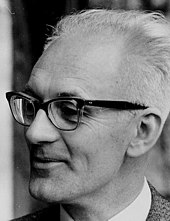Cornelis de Jager
Cornelis de Jager (born April 29, 1921 in Den Burg , Netherlands ; † May 27, 2021 there ) was a Dutch astronomer who mainly dealt with the sun and the spectra of the stars. He worked in Utrecht at SRON (Space Research Organization Netherlands), the predecessor of which he founded in 1961.
Life
De Jager was born on the Dutch island of Texel . At the age of five the family moved to the Dutch East Indies (today: Indonesia), where his father became the school director on the island of Sulawesi . He returned to the Netherlands to study at the age of 19. He started studying physics at the University of Utrecht . The first lecture was on astronomy and motivated de Jager to study astronomy instead of physics. That was against the will of the father. When the Second World War broke out, de Jager tried to cross over to England in a canoe to join the Allied troops. The crossing was prevented by the German occupiers. In 1943 he refused to sign a German loyalty document. That is why he and a fellow student hid in the Sonnenborgh observatory in Utrecht until 1945. He could make use of the library there for his self-study.
Act
Cornelis de Jager received his doctorate in 1952 under Marcel Minnaert at the University of Utrecht with a thesis on the hydrogen spectrum of the sun. In 1974 he received the Karl Schwarzschild Medal of the Astronomical Society for his work Dynamics of Star Atmospheres , in 1984 the Jules Janssen Prize , in 1988 the gold medal of the Royal Astronomical Society . Cornelis de Jager had been a member of the Royal Netherlands Academy of Sciences (KNAW) since 1969 . He was also a member of the Royal Flemish Academy of Belgium for Sciences and Arts and a member of the Committee for the Scientific Investigation of Claims of the Paranormal . Since 1987 he has been a member of the Leopoldina and since 1990 of the Academia Europaea .
His work also includes investigations into the influence of solar activity on the earth's climate . He came to the conclusion that the sun, in addition to the human contribution, has a significant influence on climate changes on earth.
Radosophy
With the so-called "Radosophy" (in the Dutch original Velosophie , Engl. Cyclosophy ) de Jager parodies the numerical mysticism of numerological phenomena such as the pyramidology of Charles Piazzi Smyth . Radosophy was published in the Skeptical Inquirer .
De Jager had measured four parameters of his Dutch bicycle (pedal travel, diameter of the front wheel, the lamp and the bell) and showed that a number of physical constants and astronomical values can be calculated from these few parameters with simple mathematical operations. For example, he calculates the distance between the earth and the sun (in hundred million kilometers) using . Further exemplary calculations for the quotient of the masses of protons and electrons , the gravitational constant , the fine structure constant and the speed of light are performed by him.
literature
- Cornelis de Jager: What is radosophy? In: Gero von Randow (Ed.): My paranormal bike and other occasions for skepticism, discovered in the “Skeptical Inquirer” Rowohlt Taschenbuch Verlag, Reinbek 1993, pp. 23-30, ISBN 3-499-19535-6
Individual evidence
- ^ Report in the Dutch newspaper AD
- ^ New Scientist , Dutch edition, May 2021, pp. 20-25.
- ^ Members: Kees de Jager. KNAW, accessed October 19, 2017 .
- ↑ KVAB class Natuurwetenschappen (Buitenlandse Leden): kvab.be
- ↑ Directory of members: Cornelis de Jager. Academia Europaea, accessed October 19, 2017 .
- ↑ Cornelis de Jager, S. Duhau, B. van Geel: Quantifying and specifying the solar influence on terrestrial surface temperature (PDF; 882 kB) April 7, 2010. Accessed June 24, 2011.
- ^ Solar Activity and Climate . Retrieved June 24, 2011.
Web links
- Homepage
- Literature by and about Cornelis de Jager in the catalog of the German National Library
- Publications by C. de Jager in the Astrophysics Data System
- What is radosophy? from the alpha-Centauri television series(approx. 15 minutes). First broadcast on Apr 1, 2001.
| personal data | |
|---|---|
| SURNAME | Jager, Cornelis de |
| BRIEF DESCRIPTION | Dutch astronomer |
| DATE OF BIRTH | April 29, 1921 |
| PLACE OF BIRTH | Den Burg , Netherlands |
| DATE OF DEATH | May 27, 2021 |
| PLACE OF DEATH | Den Burg , Netherlands |

![{\ frac {{\ sqrt {{\ text {Pedal travel}}}} \ cdot {\ sqrt [{3}] {{\ text {Bell}}}}} {{\ text {Lamp}}}}](https://wikimedia.org/api/rest_v1/media/math/render/svg/42ef26ddd00c955a10b91cbd10f0f8625a0e0661)